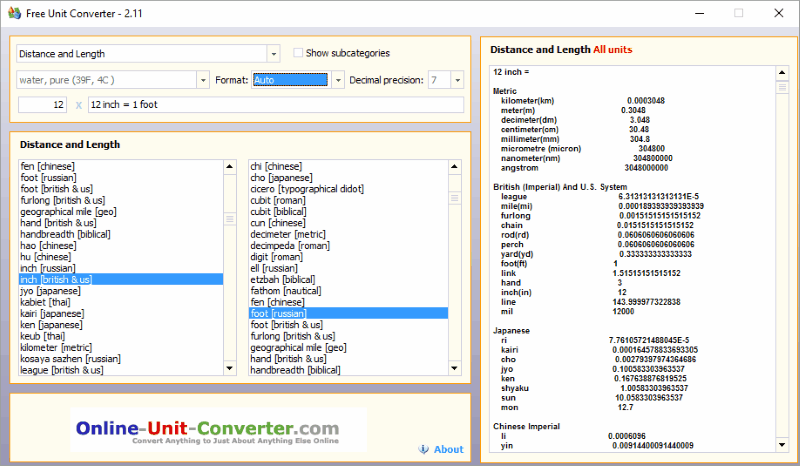The Ultimate Guide To Inches To Centimenter
Wiki Article
The Best Guide To Inches To Centimenter
Table of ContentsAbout Inches To CentimenterThe Definitive Guide to Inches To CentimenterAbout Inches To CentimenterUnknown Facts About Inches To Centimenter
This makes finding out System Conversion Tool a breeze and will increase your productivity dramatically while flattening the learning curve. You can save great deals of time by utilizing the global converter as it operates in offline setting as well. As well as it supplies you exact conversion results in practically all systems offered for measurements.99% exact solution (inches to centimenter). Because Universal Converter application is readily available complimentary on shop for all platforms, simply download and install the application from store, set up the app on your smart device and also open up the app, select your conversion units and afterwards kind in the value and also click 'Convert' for results. This application is easy to use user interface with providing instant as well as precise result.
This shows to be a best remedy for area job and you are basically assured to locate the exact conversion unit when required! Easy to use Interface Offers Accurate Outcome Immediate Output No requirement for Web Link Provides converted outcome in all Feasible Devices Global Converter gives a precise as well as immediate outcome to all inputs.

Inches To Centimenter Things To Know Before You Buy
Thank you for your set of questions (inches to centimenter). Sending completionBelow is a helpful and instructive reader-contributed device conversion utility which has been sent for addition to the official Revit SDK examples. We reviewed the Revit unit handling in among the very first blog posts to this blog site. One bottom line reviewed there is the fact that Revit inside makes use of a fixed collection of internal database devices which can not be altered.
The article mentions the simple system converter provided by the Midas, Link sample, that makes usage of hard-wired self-maintained conversion constants, and also suggests an easy hands-on manual approach for determining any type of called for conversion variable (inches to centimenter). The device conversion utility presented below demonstrates exactly how this procedure can be automated to stay clear of the need for any hard-coded conversion aspects at all.
One usage of this is to transform and show the internal Revit database systems to whatever units the individual likes to see in the individual interface. It would certainly behave to access this performance from our outside add-in applications also, rather than maintaining our very own conversion regimens. We already talked about one idea for a strategy to access the interior Revit functionality to layout device strings making use of the As, Value, String and also Establish, Worth, String methods on the Criterion class.
Inches To Centimenter Fundamentals Explained
For completeness' benefit, we likewise point out an additional location related to devices that we discussed briefly, the expedition of device types and style choices by Matt and also Saikat. The aptly name Unit, Conversion energy provided below demonstrates accessing the internal Revit unit handling performance to implement the inverse direction also, as well as additionally gives a anonymous handy customer interface for determining as well as checking device handling performance and also conversion variables.

If your job systems for Size are readied to inches, and you save right into a specification making use of Establish, Value, String the string value for 12, Revit will immediately convert 12 inches into 1 foot and actually save the value of 1 for you into the specification. Using Set, Value, String, you don't even have to know that Revit has an inner unit of action, allow alone what those systems of procedure are. inches to centimenter.
The Main Principles Of Inches To Centimenter
click over here now If, for example, your project units for Length are set to centimetres and you send out the string value: 18" (with the trailing dual quotes), Revit will certainly analyze that as eighteen inches as well as will certainly save the value 1. 5 (one as well as a half feet) right into your specification for you. As another example, having your task units for Length set to meters and also utilizing Establish, Worth, String with the worth: 2' 3" (consisting of the single as well as dual quotes) will certainly store the value 2.Revit recognizes exactly how to do all this the string parsing for you, as well as will certainly toss an exception if you attempt to send it something it can not analyze. A parallel reverse function called As, Value, String additionally exists in the Revit API. This will certainly transform a parameter's internal value back to the string depiction for the present job units.
5, calling As, Worth, String will return the string 3' 6". Using this expertise, it is possible to create techniques which can be used to help fix the system conversion trouble much a lot more easily. We can compose a feature to return the range aspect (multiplier) that is required for a specific collection of units of action.
If we desire to save 1000 CFM right into Revit, we have to keep the worth 16. For the mathematically likely, this scale variable relates to 1/60, which tells us the internal units Revit makes use of for air circulation are Cubic-Feet-per-Second. inches to centimenter.
Report this wiki page